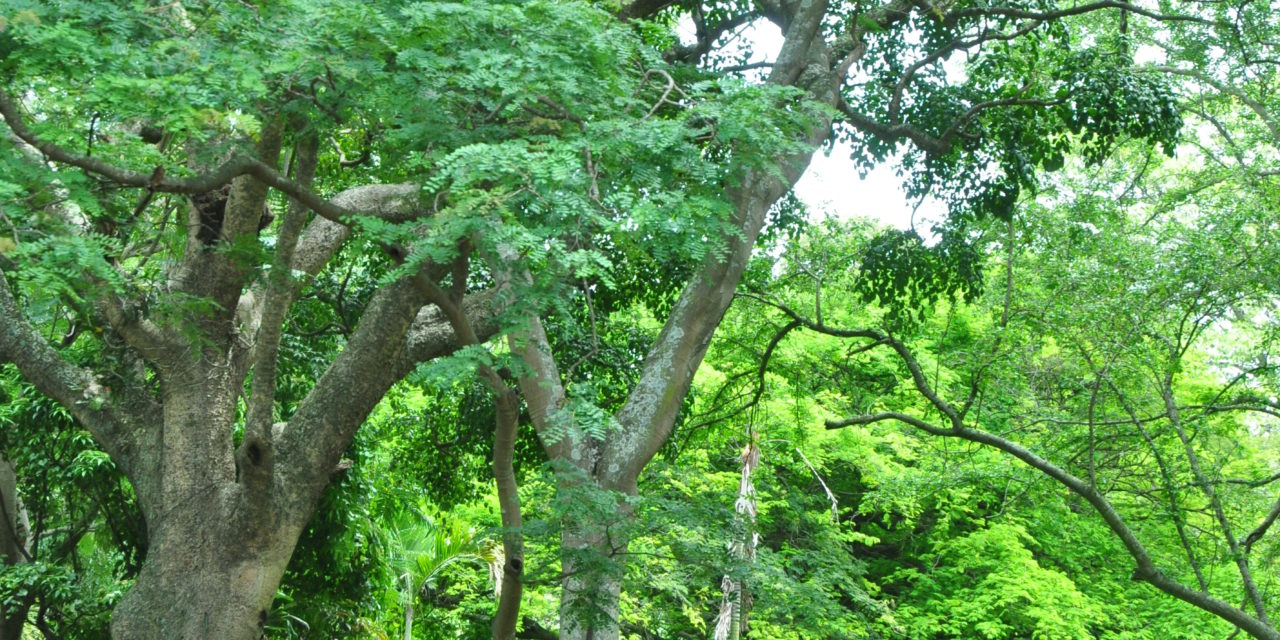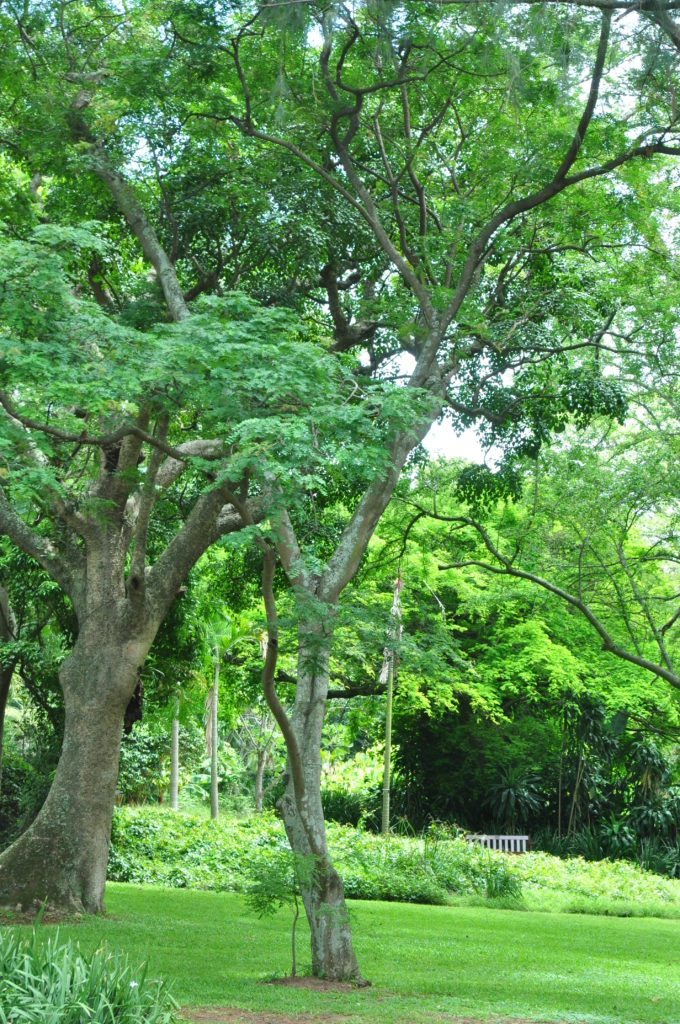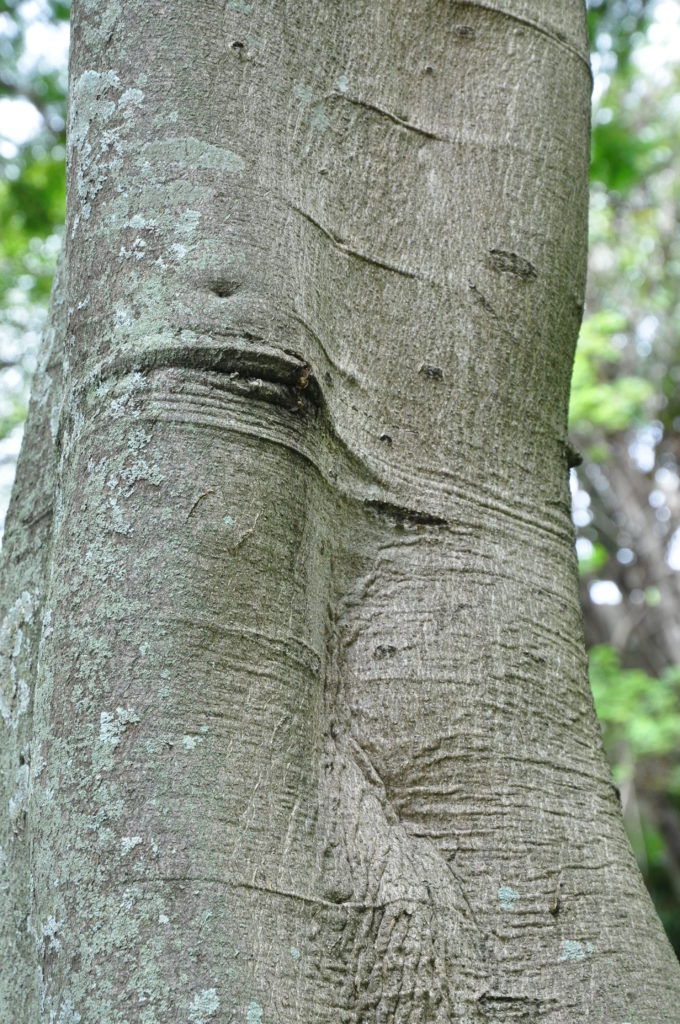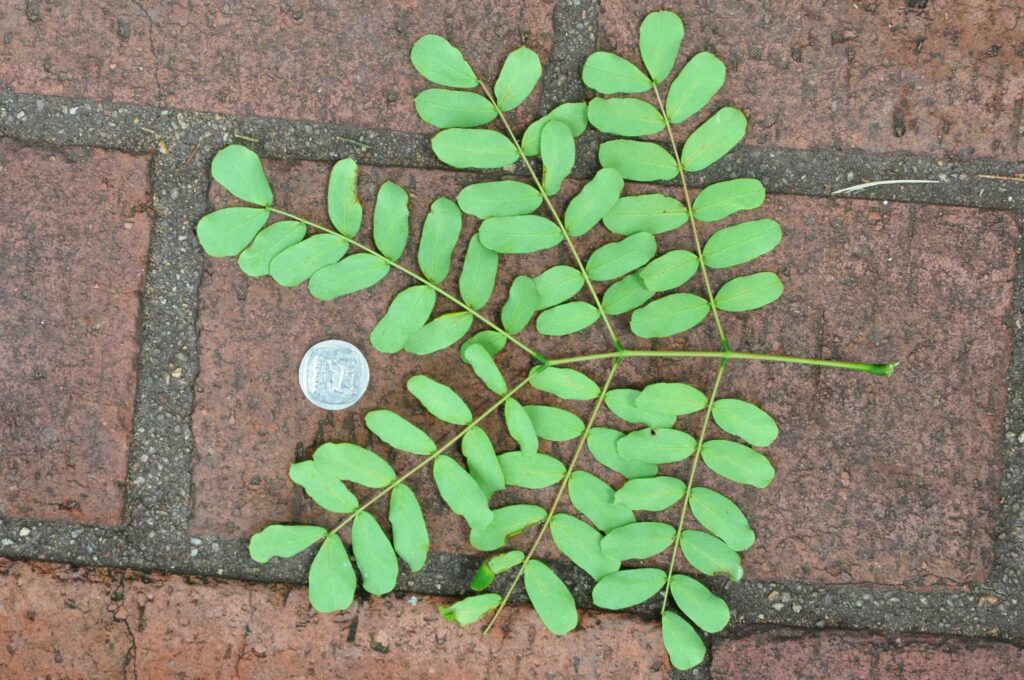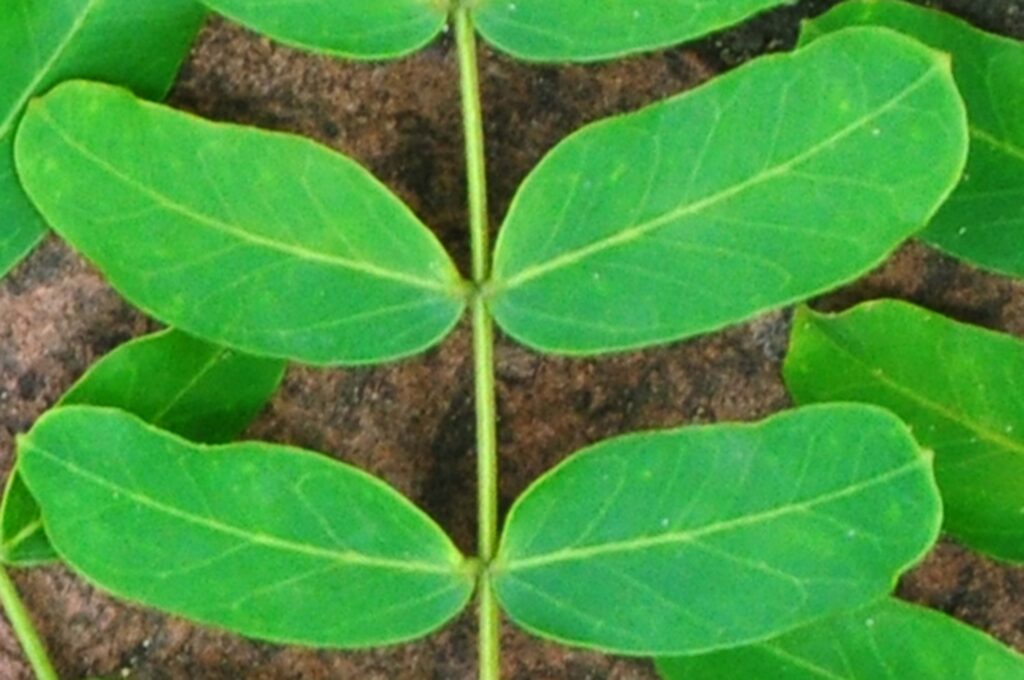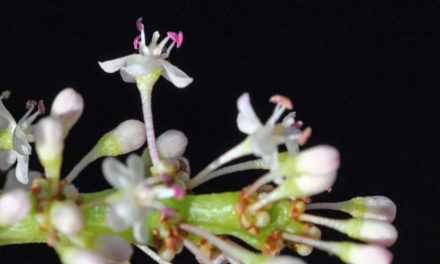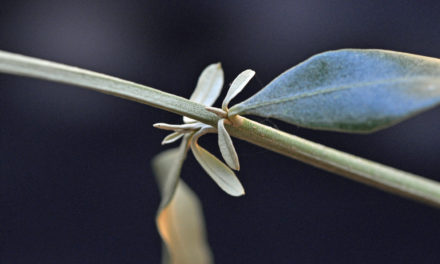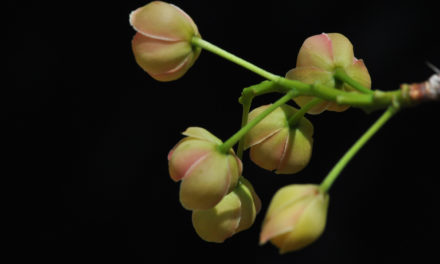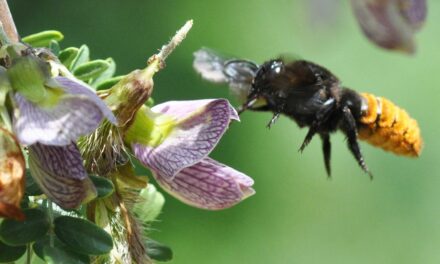General Info – summary
The unarmed Tree with a straight trunk and grey bark may reach 15m high. Thick blunt-tipped branchlets are hairy when young. Bipinnate Leaves have wavy, spaced apart, asymmetric leaflets and non-spinescent stipules. Regular, bisexual Flowers in half-spherical head have fluffy exserted, whitish stamens producing colour. The superior ovary has a simple extending style Fruit an indehiscent pod + flat, hard round seeds.
Description
Albizia suluensis
Previous Names: Nil.
SA Tree No. 156.
Common names: (Afr) Zulu-valsdoring. (Eng) Zulu False-thorn, Zulu Albizia. (isiZulu) Ingwebu-enkulu, Ungwebo-omkulu, Unyazangoma.
Family: Fabaceae or Leguminosae. (Fabaceae, or Leguminosae (Pea, bean or legume family). After the Orchidaceae and the Asteraceae, the Fabaceae is the third largest Angiosperm (flowering plants) family with 700+ genera and close to 20 000 species. Local Tree genera on this website include Acacia (Vauchellia, Senegalia), Albizia, Bauhinia, Bolusanthus, Burkea, Calpurnia, Colophospermum, Cordyla, Cyclopia, Dichrostachys, Erythrina, Erythrophleum, Faidherbia, Indigofera, Mundulea, Peltophorum, Philenoptera, Piliostigma, Schotia and Xanthocercis. The Fabaceae are recognisable by their fruit and by their pinnately compound Leaves. Leaves may also be simple – even bilobed and usually have stipules – some of which may be spinescent. Leaflets are usually entire. Flowers are bisexual and bracteate. Regular flowers usually have 4-5 sepals and the same number of petals. Irregular flowers have 4-5 sepals and 5 or less petals. Stamens have anthers that have 2 pollen sacs and there are usually at least twice the number of stamens as petals – often 10. The superior Ovary has one locule that may contain 1 or more ovules. The Stigma and Style are simple. The single carpel develops into the Fruit, which is usually a pod. This pod dehisces on both sides and may break into segments. Seeds vary.
Name derivation: Albizia: Named after Filiopo degli Albizzi who introduced a species to Europe in 1749. suluensis from Zululand (Kwa-Zulu Natal). There are 11 indigenous species of the genus Albizia in southern Africa.
Conservation: National Status: Endangered. Assessed: 2014 (C.R. Scott-Shaw, J.E. Victor, L. von Staden and A.E. van Wyk). This species occurs in areas where employment rate is low and where wood is used for building, fuel and for medicinal use. The area is also being cleared for subsistence farming and is becoming home to the alien plant Chromolaena odorata (paraffin weed – pungent aromatic odour when crushed.) which is native to both North and South America. This invasive and flammable weed affects species diversity. The population trend of Albizia suluensis is decreasing.
Tree
This unarmed (no thorns or spines) Tree has a straight Stem (or trunk and is the main axis of the plant i.e., the leaf and flower bearing as distinguished from the root-bearing axis. The stem is usually up to 10m but may reach 15m high. The often-spreading Crown may be rounded or flat. The thick Branches are rounded. The tree usually has a straight trunk with grey, smooth (photo 212) or fissured Bark. Thick Branchlets are blunt-tipped and hairy for a short time when young.
- 211 2015.02.09 Durban BG. Photo: David Becking.
- 212 2015.02.09 Durban BG. Photo: David Becking.
Leaves
This deciduous tree has dark green Leaves that are bipinnate (compound: twice pinnate) and up to 15 x 15cm. The Petiole (leaf stalk) is up to 7cm long and is grooved on the upper surface. The Rachis (photo 209 is the extension of the petiole of a compound leaf that eventually bears all leaflets). Here it is up to 8cm long and has lateral Pinnae “branches” not leaflets and the Pinnules “leaflets” are on these “side branches” – photo 209). This photo shows each pinna ending with 1 pair of pinnules that are usually Obovate (upside down egg-shaped), whereas the remainder of the pinna may be nearly rectangular, obovate, or oval. The 2-5 pairs of pinnae each bear 4-9 pairs of large pinnules/leaflets that are up to 2,5 x 1,3cm. There is a small gland at the base of the lowest pair of pinnae. The Pinnules are dark blue green above (photo 208) and lighter below (photo 209). Leaflets may be slightly hairy but do not overlap (photo 208). The Margin is distinctly wavy – unusual in Albizia leaflets (photo 208). In this photo, the pointed Apex is rounded or square and may be attenuate (showing a long gradual taper of base or apex). The Base is asymmetric (photo 208). The Stipules (basal appendages of the petiole) are not spinescent and usually shed early. Short Petiolules (pinnule stalks) are also present and often sparsely pubescent (hairy).
- 209 2015.02.09 Durban BG. Photo: David Becking.
- 208 2015.02.09 Durban BG. Photo: David Becking.
Flowers
The golden velvety buds (calyx) open into creamy-white or pinkish Flowers in a fluffy, half-spherical head. The Pedicels (stalks of a single flower) are up to 4cm long. Flowers are actinomorphic (Regular, symmetrical. They are vertically divisible into similar halves by more than 1 plane passing through the axis). The Calyx, which is up to 4mm long, has golden velvety hairs that colour the buds. It has a tube ending in short lobes. The Corolla has a funnel shaped tube that is at least as long as the calyx. It usually has 4 lobes with rusty coloured hairs. The many fluffy exserted (sticking out; projecting beyond) Stamens are up to 1,6cm long and are united at their base. They are whitish, giving the flowers their colour. The Anthers are peltate (shield-shaped) with the thecae (pollen sacs) opening outwards. The superior Ovary extends into a filiform (thread or filament like) Style which ends in a simple Stigma. This eventually extends beyond the anthers and this late development helps ensure cross-pollination. (Nov-Jan).
Fruit
The Fruit is a wide, light brown, linear indehiscent Pod up to 20 x 2,6cm. Surface veins are indistinct. It has a slightly thickened margin and individual seed position is emphasised by small swellings. The hard Seeds are flat and round. (Jan-Sep).
Distribution & Ecology
This Tree is endemic (Endemism is the ecological state of a species being unique to a defined geographic location) in northern KwaZulu-Natal near the towns of Hlabisa and Hluhluwe. Trees often occur on forested scarps (steep slopes of land that cut across the underlying strata), forest margins, open woodland and on riverbanks but not close to the sea. The altitudes range is from 270-1 400m, and they may occur in groups. In the afternoon, the long-tailed Sanango monkeys (slightly larger than the Vervet monkeys) consume the Leaves. Butterflies also visit the Flowers.
Ethnobotany
These endangered Trees have a limited distribution and grow best in full sunlight. They develop into good ornamental trees. The outstanding hard and durable Wood has been used to make good furniture. Sawdust causes sneezing. Bark has medicinal uses. Like most, “Acacia” trees, the seeds germinate better if they are first soaked in boiling water and left-over night. It takes up to 10 days for the Seeds to germinate.
References
Boon, R. 2010. Pooley’s Trees of eastern South Africa. Flora and Fauna Publications Trust, Durban.
Coates Palgrave, M. 2002. Keith Coates Palgrave Trees of Southern Africa, edn 3. Struik, Cape Town.
Lawrence, G. H. M, 1951. Taxonomy of Vascular Plants. The Macmillan Company, New York. Tenth Printing 1965.
Palmer, E. & Pitman, N. 1972. Trees of southern Africa. Balkema, Amsterdam, Cape Town.
Scott-Shaw, C.R., Victor, J.E., von Staden, L. & van Wyk, A.E. 2014. Albizia suluensis Gerstner. National Assessment: Red List of South African Plants version 2020.1. Accessed on 2022/08/19.
https://en.wikipedia.org/wiki/Chromolaena_odorata
https://plants.jstor.org/compilation/albizia.suluensis
http://pza.sanbi.org/albizia-suluensis
http://wiredspace.wits.ac.za/bitstream/handle/10539/5313/Faraday%20Report%20Appendix.pdf

